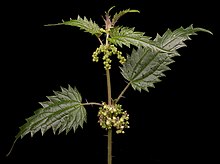

| Urtica incisa | |
|---|---|

| |

| |
| Scientific classification | |
| Kingdom: | Plantae |
| Clade: | Tracheophytes |
| Clade: | Angiosperms |
| Clade: | Eudicots |
| Clade: | Rosids |
| Order: | Rosales |
| Family: | Urticaceae |
| Genus: | Urtica |
| Species: |
U. incisa
|
| Binomial name | |
| Urtica incisa | |
Urtica incisa, commonly called scrub nettle, stinging nettle, and tall nettle,[1] is an upright perennial herb native to streams and rainforest of eastern and southern Australia, from the north–east southwards through the east, of Queensland and New South Wales, then across the south, through Victoria, Tasmania, south-eastern South Australia and parts of southern Western Australia.[2][3] The species is also widespread in the North and South Island of New Zealand.[4]
Scrub nettle leaves are triangular and opposite, 5–12 centimetres (2.0–4.7 in) long, with serrated margins and stinging hairs.
Indigenous Australians ate the leaves after baking them between hot stones. They are considered a tasty vegetable, with colonists also using it to make a tonic for "clearing the blood".[5]
This Urticaceae article is a stub. You can help Wikipedia by expanding it. |